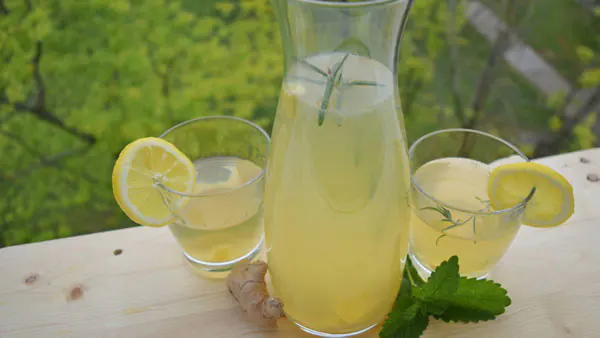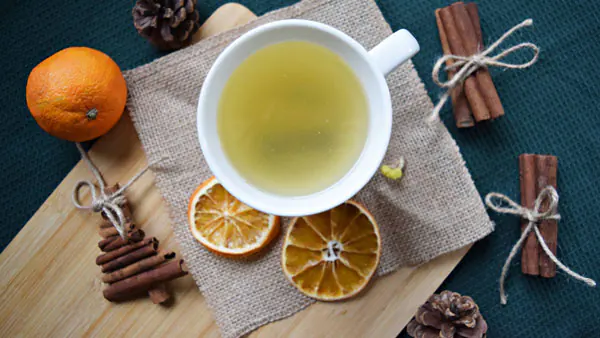Preparation time: 15 minutes ❀ Difficulty of preparation: Simple ❀ Number of servings: 1
Ingredients:
| 2 tsp dried rose petals and/or buds |
| 1 water (2 dl) |
| 1/2 tsp honey |
| 1/4 tsp cinnamon (optional) |
Preparation:
- Add 1–2 teaspoons of dried rose petals to a cup and pour over hot water.
- Cover and let it steep for 10–15 minutes.
- Strain the tea and sweeten with honey if desired.
- Optionally, add a pinch of cinnamon for extra flavour.
Before serving, you can add a few fresh, untreated rose petals to the tea for a special touch. Rose tea has a mild, delicate, and gentle flavour. The petals give a subtle floral aroma, similar to the scent of a fresh rose, which is not overpowering but light and soothing. For a stronger taste, you can combine rose with other dried herbs. It pairs wonderfully with linden, elderflower, hibiscus, and rosehip.
Health benefits of rose tea
The rose is one of the oldest flowers in the world and is often mentioned in mythological stories as a symbol of love and beauty. In addition to their uplifting fragrance, rose petals contain significant amounts of vitamins and antioxidants. According to WebMD, drinking rose tea has traditionally been associated with various health benefits:
- contains vitamins E and C – strengthens the skin and acts as an antioxidant,
- contains polyphenols – supports heart health and overall well-being,
- may help with stomach and digestive issues,
- may relieve menstrual cramps and minor inflammations,
- helps combat fatigue and improve sleep,
- soothes and supports mood.
Due to its aromatic and therapeutic properties, roses are often used in skincare products and are particularly prominent in Chinese cuisine and traditional medicine.
Drying and storing rose petals and buds
Dried rose petals can be found in most health food stores, but it is far more enjoyable to collect and dry them yourself. In doing so, it is very important to choose garden roses that have not been treated with harmful chemicals. For tea, the most suitable rose varieties to dry are fragrant ones, such as the Damask rose (Rosa damascena), the Gallica or French rose (Rosa gallica), and the Hundred-Petalled rose (Rosa centifolia).
Roses are best picked during their main flowering season, usually from late spring to mid-summer. Harvest them on warm, sunny mornings, after the dew has dried but before the hottest part of the day. That’s when the blossoms are richest in fragrant oils and most suitable for tea. When picking buds, choose those that have just begun to open, but not too far, as very young buds tend to shrivel when dried. For petals, it is important that they are fully open, yet still fresh and firm.
Easy steps:
- Harvesting: Gently pluck the petals with your fingers, pulling softly. To harvest buds, carefully cut them just below the calyx.
- Drying: Spread the petals and buds on a clean surface, making sure they do not overlap. Leave them to dry for 1 to 2 weeks in mild shade, in a dry and warm room with good air circulation. Gently shake them each day to ensure even drying.
- Storage: Keep the dried petals and buds in a sealed glass container, stored in a cool, dark, and dry place.
It is very important to choose garden roses that have not been treated with harmful chemicals.
Creative uses of rose petals and buds
Rose petals and buds can be added to a variety of dishes and drinks, and are especially suitable for decorating desserts. Thanks to their aromatic and decorative qualities, they add a touch of creativity to any dish. For example, in a homemade chocolate recipe, dried rose petals were used as a creative touch for decorating personalised chocolate.
Roses are also commonly used in homemade natural cosmetics and aromatherapy products. Rose waters, scented oils, aromatic baths, and facial masks are particularly popular in natural skincare. Dried rose petals can be also used to create fragrant potpourris in small bowls or cloth sachets. For a stronger scent, the petals can be mixed with essential oils to refresh a room or wardrobe effectively. Such scented decorations make perfect gifts for our loved ones, especially when crafted with love.
At a time when beautiful roses adorn almost every garden, rose petals offer many creative possibilities – from the simple preparation of rose tea to various other creative projects. Sometimes, a soothing cup of tea is all we need to relax, especially when we choose aromatic, organic, and medicinal herbs that benefit our health. Enjoy your tea and any creative work!



